Just as I’m about to head to the Wild East for an Appalachian Trail adventure in the highlands of North Carolina and Tennessee, I feel a tug to stay here at home in my wild front yard in Bend, Oregon. Each day I wake before 5 a.m. to the fast chips of calliope hummingbirds seeking nectar in the blue hour before dawn.
Nighthawks cleanse the awakening sky with their peeeent nasal calls. Sickle wings cleave the chill air and their beaks open wide to gulp flying insects. A little more light, and now the ravens are rolling their Rs from high in a ponderosa pine. The nesting pair often chat this way as if in raven Spanish or raven Italian. To prove they really are ravens, they’ll toss in the obligatory croak or squawk. Their emphatic pronouncements overshadow even the neighbor’s crowing rooster.
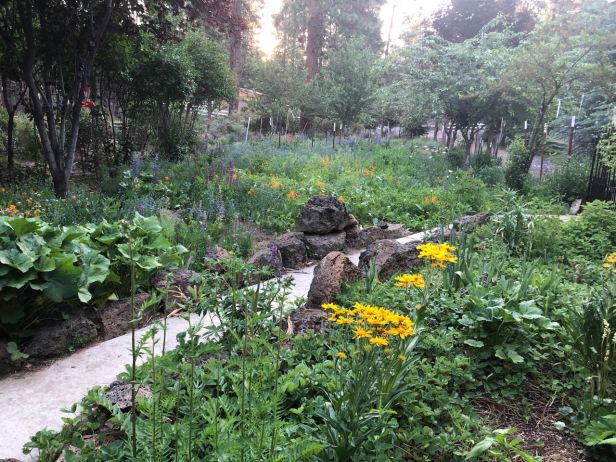
As daylight stirs, the dawn anthem of robins, chickadees, finches, nuthatches, goldfinches, and siskins commences. Their chirrups, zings, and dee dee dees unfurl the halcyon moment.
By mid-morning, the sun heats our wildflower yard. Butterflies, bees, beetles, flies, wasps, ants, and a myriad of other insects bustle upon blooms and stems. I’ve spent almost an hour sitting among the flowers observing a kaleidoscope of insects that would go unnoticed without—staying put. I’m enthralled by a world that I know so little about, yet is right here—invited in by native plants blooming in a progression throughout the spring, summer, and into fall.
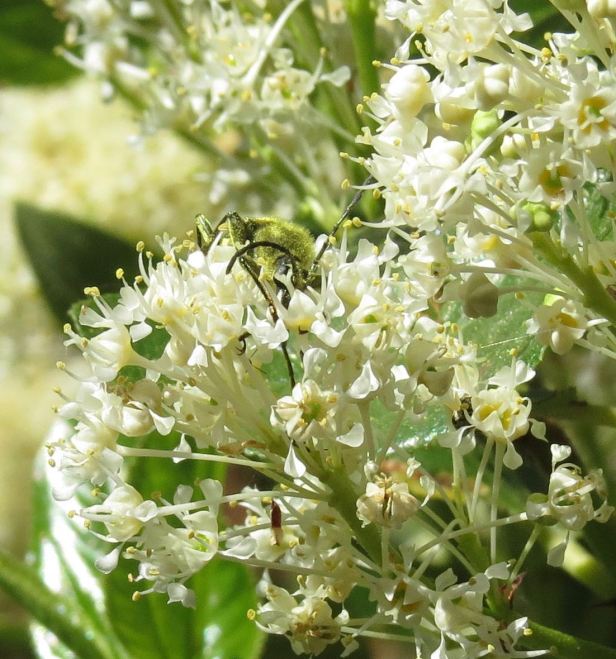
I can recognize wasps from their thin bodies and long dangling legs and know that they are critical to the dynamic ebb and flow of insect life. They serve as predators that keep certain insect populations in check.
Pollinating bees vanish into the sensual folds of lupine blossoms. Ants cruise up and down plant stems and over flowers. A painted lady butterfly balances on sun rays of our native plant called owl’s claws. A spider the size of a peppercorn crouches in a web cupped between ceanothus leathery leaves. I watch and nature comes to me.

When a skinny, staple-sized insect with translucent wings, a long neck and a ferocious little head lands on my arm, I take a photo and hurry inside to look for a match on INaturalist. Voila! This is a snakefly, a predator of aphids and as such ought to be celebrated by gardeners. I find a wonderful article, learning that this tiny creature evolved 140 million years ago in the Mesozoic. The author describes a snakefly like this: “With the head of a beetle, body of a wasp, and—if female—a fiendish-looking “tail,” snakeflies seem to be assembled from spare parts, like the late-night opus of some mad and meddling Dr. Frankenstein.”

Even from my window typing on the laptop, I can keep watch on the flowers that tumble across more than a quarter of an acre. A Pygmy Nuthatch flusters onto the feeder and nips a sunflower seed, then wings away. Mountain Chickadees sip from our bird bath. A purple flax bends from the weight of a landing bumblebee.
A few weeks ago, Wes added a mason bee nesting box —built by Ron Spendal, Oregon’s mason bee ambassador, featured on the PBS TV show, Oregon Field Guide. Standing close to the new home for these invaluable pollinators, I’m thrilled to see a dark little bee whizzing in and out of the tunnels drilled into wood shelves. Females collect mud to daub into the back of a tunnel, add pollen and nectar, lay an egg, and then seal the chamber with more mud. The process continues until the tunnel fills up. When the larvae hatch, they have a feast waiting.

What will we miss in our two weeks away? Only in the last few days have all the lupines erupted in purple and blue towers. Ceanothus blossoms like white sea foam scent the air with a sweet and slightly musky scent. I can see the promise of poppies and columbines. Sunflowers seem to grow while I watch—from a few inches to a foot.
Yes, all will be here upon return. Yes, I’m delighted to be heading East to see family and to journey to my father’s favorite part of the Appalachian Trail, joined by Wes and by my son Ian. I’ll delve in there to nature’s wild pollinator gardens, to eastern birds, and the forecasted thunderstorms. Our pace will be slow—much slower than my father’s journals tell me he hiked, sometimes covering more than 20 miles in a day. I’m recovering from a hamstring injury, and forced into a naturalist’s pace. The silver lining? I have no choice, but to take time to smell the flowers.
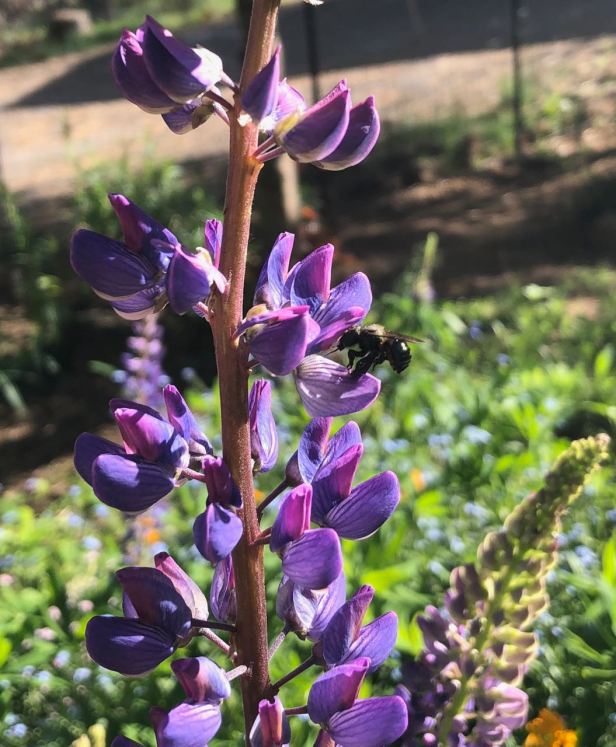
June is pollinator garden month and next week, June 17-23, is pollinator week. My advice? Immerse yourself among the wild native blooms wherever you are. Plant yourself like a sunflower for even a few minutes. Notice the world humming in your ears. Celebrate the bounty of native plants that support caterpillars that in turn feed hungry songbird chicks. Sing your own anthem to pollinators that need our help desperately and are in turn the key to our own survival, too. Find home among the wildflowers.
Our yard is part of the Million Pollinator Garden Challenge. You can add yours, too, and certify as backyard wildlife habitat with wild food, shelter, and water for birds, insects, and other wildlife—like our pine squirrels, western gray squirrels, chipmunks, lizards in the lava rocks, and mule deer that we fence out of our front wildflowers, but they freely nibble the manzanita and other native shrubs of our backyard.
To take action, plant three blooming native plants–one for spring, one for summer, one for fall. For terrific advice on native plants that tell you how many butterfly and moth larvae they host, please see the NWF native plant finder. You can look up your own place by zip code. Every pollinator garden truly makes a difference.
Farewell our little piece of wild paradise for now. We will return soon to you.
Meanwhile, here are a couple blogs from last year–the first for our pollinator garden adventure. In July last year, poppies flourished: In Praise of Bees in our Yards. You can see the tall sunflowers of September here: Everywhere is Home.
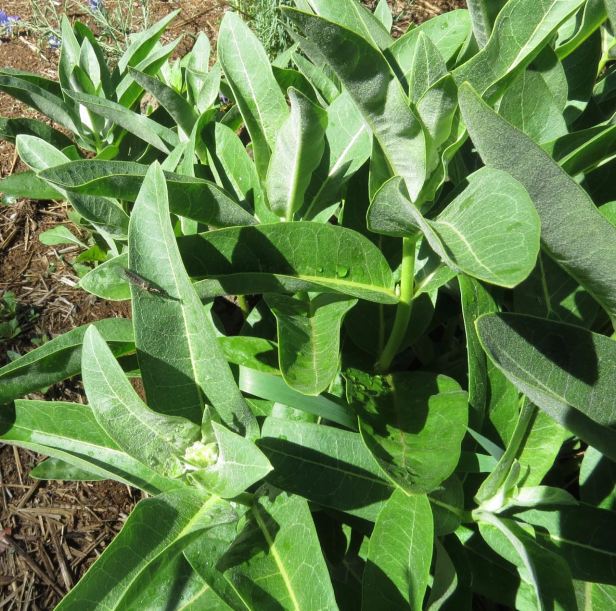

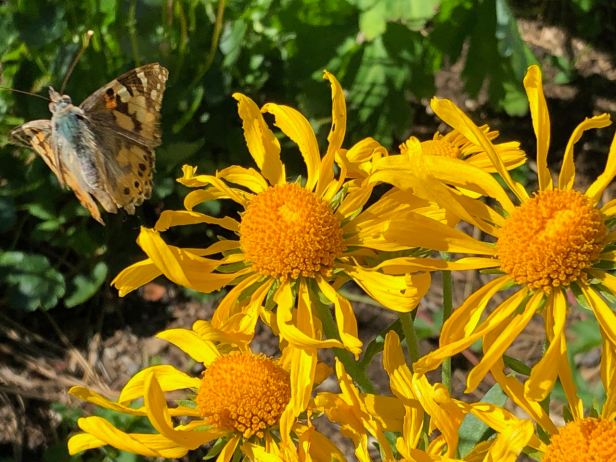

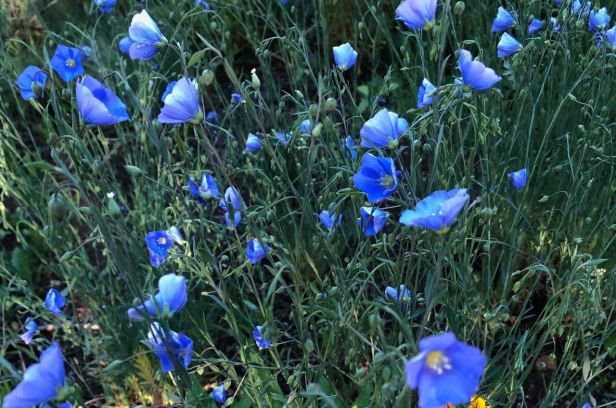




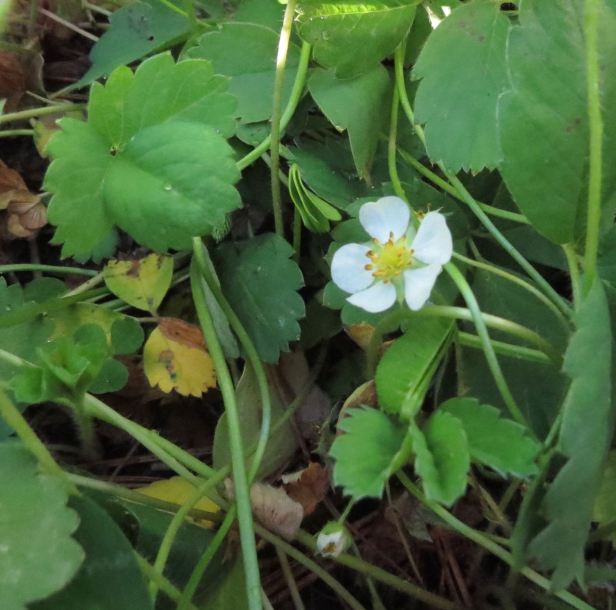



Glorious photos, glorious words. Thank you for slowing me down this morning, to stop and smell the flowers of your back yard and in mine. So glad you’ll be ambling along your Dad’s beloved trail soon, and will then return to that life-filled garden of yours.
LikeLiked by 1 person
Wonderful blog and yard. Have an amazing journey in the east.
LikeLike
Great work, Marin! I’m inspired!
LikeLiked by 1 person
Love this blog. I am working away on my own back yard, replacing swaths of grass with native, xeric
plants and shrubs. I have quite a ways to go!
LikeLiked by 1 person